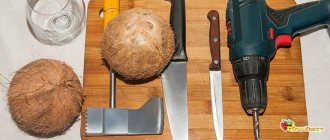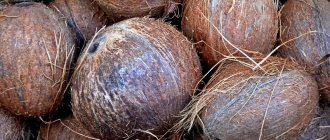Having visited exotic countries and tasted overseas delicacies there, you come home and find some of the gifts of nature in your supermarket. Yes, yes, now you can often find fruits and vegetables from different countries in our stores. And so you decided to please yourself and your family with coconut. But did you know how to peel a coconut?
Those who pick up an unshelled hairy nut for the first time do not even know which side to approach it from in order to get the precious insides. Our instructions and useful recommendations will simplify your path to pleasure.
What you will need
In order to properly and quickly peel a coconut, you will have to look in the pantry and find the following tools:
- Screwdriver
- Hammer
- Hacksaw
- Machete.
At this stage, girls usually begin to worry that if such male devices are needed, then a strong male hand will be needed. Of course that would be ideal. But, believe me, if everything is done correctly, even the most fragile lady will be able to get to the core of the nut.
In addition to the tools listed, prepare a glass, spoon and bowl.
Ready? Let's get started!
Using a hacksaw or small saw
Using this tool you can carefully extract the pulp. In this case, you will have to use physical force.
The essence of the method is to methodically saw the coconut shell with a hacksaw (small file). The movements may shift slightly towards the coconut “crown”. In this case, you can get an original cocktail bowl. However, extracting the pulp in this case will be more problematic.
Let's get to the point
There are several cleaning methods. Depending on further use, choose the one that suits you best. Since you can peel a coconut at home for food, then the technology is not important, but if you are going to not only eat the nut, but also make crafts from the shell, there will be nuances.
Method 1
The first method is for those for whom it is important to quickly get to the pulp and juice, and the appearance of the shell is completely unimportant.
- Find three eyes on the coconut and pierce them with a screwdriver. If necessary, help yourself with a hammer.
- Pour the liquid into the glass through the resulting holes.
- Then grab a hammer or machete and get to the fun part. If you are right-handed, then take the fruit in your left hand and the tool in your right. Your task is to tap the nut in a circle with a hammer, turning it as you do so. The experts say that you will need to make 3 full circles and the nut will open. It may take longer the first time.
Hold the fruit in your hands, do not put it on the table. This is precisely the secret to quick cleaning.
- After just a few impacts, cracks will begin to appear on the surface. Don't give up until you have completely cracked the coconut.
- You can separate the pulp from the peel with a spoon. Sometimes it is advised to put the nut in the oven for 30 minutes before doing this, then the white part will be more pliable.
Method 2
If you need the peel intact, for example, to make a bag, a Christmas tree decoration, or use it as a bowl for serving fruit, this method is for you.
- First, drain the juice, as mentioned in the previous paragraph.
- Now take a hacksaw and start sawing along the seam.
This process is not as quick and simple as the last one, but it will allow you to get two equal halves.
If you move the cut line upward and cut off only the top, you can use the container as a flower pot.
More options
But how can you peel a coconut at home if you don’t have any tools at hand? Don't despair, there is a way out!
Remember those TV programs about survival in the wild? There, brave souls left on a desert island remain alive thanks to coconuts. It’s lucky if you have a machete with you, but you may not have it, just as you may not have any equipment at home.
You will need any sharp object, such as a brick, stone, or the corner of a table. Press the seam of the nut against the point and rotate it until it is completely open.
Another option is shock therapy using heat and cold.
Before starting the procedure, drain the juice.
You need to put the coconut in the microwave or oven (200 C) for 15 minutes. Then put it in the freezer for 15 minutes. When you take it out of the cold, tap it with a knife and it will open easily.
Drain the milk
First you need to drain the coconut milk. This will make the work much easier. Take a sharp object and poke a hole in the nut. The fruit must be firmly secured with three dots at the top
From the dark spots we choose the softest. An awl, nail or screwdriver is suitable as a tool. When the hole opens, you will hear a pop. Carefully pour the milk into a convenient container.
All that remains is to find out how to get the flesh out of a coconut.
It is better to make 2 holes so that air penetrates into one of them and milk flows out of the other.
Choosing the right one
If suddenly, after opening, you notice a sour smell and find yellowed or dark-spotted flesh, immediately throw everything in a bucket. You shouldn’t eat this, because you can get poisoned and get indigestion very quickly.
To make the right choice next time when shopping, follow these recommendations:
- Check the surface of your shaggy friend. It should be smooth, without cracks or chips.
- Smell your eyes. They should smell like a fresh coconut aroma. If you feel sour, you should not take it.
- Shake it. There should be liquid inside. If there is no feeling of fullness, then the fruit is no longer fresh.
Size matters. It is believed that the largest and most beautiful nuts will be the most delicious.
Adviсe
It is easier to separate the coconut meat if you heat it a little in the oven or microwave first. You can peel it off with a small knife or spoon.
Attention!
Fresh coconut meat is not as sweet as in famous delicacies. At first it may even disappoint. But you shouldn’t give up this fruit. Gradually, the specific taste will become “understandable” to the receptors even without sugar.
How to use on the farm
First of all, we recommend eating this storehouse of vitamins and microelements. First, you can drink the coconut water that you poured out when you opened it.
Secondly, the pulp can simply be chewed as a snack, grated into chips, added to jams, drinks, and baked goods.
Third, prepare the coconut milk.
It is a mistake to call intrauterine fluid milk. This is some water. Read below for the milkshake recipe.
- Cut the pulp into manageable pieces and place in a blender or food processor.
- Pour in 1 liter of water.
- Whisk until the water turns white.
- The resulting slurry must be filtered through a special cloth or gauze folded several times.
That's all, the coconut is milked, and in your glass you now have fresh coconut milk, which is rich in calcium and vegetable protein, which means it can be an alternative to any animal product.
By the way, do not rush to throw away the cake remaining after straining. You can make amazing cookies from it.
Similar manipulations can be used to obtain coconut oil, which is useful both in cosmetic procedures and in cooking.
You may also be interested in:
How to choose an avocado?
Features of the process of obtaining pulp
- Drain and scoop out the flesh from one fresh coconut. Grate the pulp on a coarse grater or simply cut into small cubes. Mix it with coconut water. If there is not enough water in the nut, then add regular boiled water. For one cup of coconut, you should have two cups of liquid.
- Place the ingredients in a food processor and blend on full power until they form a smooth white mass.
- Then take a very thin gauze and strain the liquid from the pieces of pulp. Pour milk into a jar.
The next method is much simpler. The nut needs to be thrown onto a hard surface. It could be a concrete wall or floor, or a thick tree trunk. Already from the first throw, a crack will appear in the shell, through which you can drink or drain the milk. The second blow (ideally) will split the nut in half. Naturally, if it is not strong enough or the surface is not too hard, more throws will be needed.
Useful composition
Since we're talking about the benefits of products, let's take a closer look at what's in it:
- Vitamins A, B and C;
- Calcium and potassium, sodium and iron;
- Protein, fats and carbohydrates, natural sugar.
The composition is impressive. One serving of this nut is enough to replenish the required daily requirement of vitamins.
Eating it has a beneficial effect on the body, maintains health and cures some diseases. Vegetarians are especially respectful of this shaggy thing and value it for all its useful components.
This fruit will be a wonderful treat on the holiday table; it will surprise and delight all guests. By the way, the cleaning procedure can be included in the competition program. The winner receives the coveted pulp.
Jokes aside, we hope that our recommendations will be useful to you and you can easily enjoy the delicious food. Well, if you still don’t fully understand how to peel a coconut, the video will put everything in its place.
Terms and conditions of storage
When buying coconut in a supermarket, it is important to understand that its shelf life depends not only on the conditions in the apartment. Much depends on the conditions under which it was transported and how long it lay on the counter. The degree of its ripeness is also important. An overripe or spoiled coconut will definitely not last long at home.
It is important to properly store coconut at home
The cut product can be stored in the refrigerator for up to 3 days. In this case, the temperature must not be lower than 4 °C. Low temperatures negatively affect the nutritional quality of the fruit, so prolonged exposure to the cold will destroy the specific taste. Too high temperatures, in turn, will provoke rotting processes.
Touching upon the issue of storing tropical fruits, it is worth touching on the topic of commodity proximity. Placing a coconut next to bananas or apples will significantly speed up the spoilage of the coconut, because these fruits are considered to be a kind of catalyst in the process of fruit ripening.
To properly store peeled coconut, it should be filled with cold water. This will preserve the unique taste and color of the pulp as much as possible.
Coconut is a rather tricky fruit, because in order to enjoy the fresh pulp, you have to work hard to clean the hard shell. However, knowing the methods listed above, you can spend a minimum of time cleaning tropical fruit.
Precautionary measures
The coconut shell is hard; opening the fruit at home is difficult, especially at first, when the skill has not been developed. When deciding to break coconuts at home, follow these rules:
- When using a hammer, chisel, or saw, take care of your fingers.
- If you plan to hit the drupe with a hammer until it splits, wrap the fruit. A thick plastic bag or several layers of cling film will do.
- Do not try to open the coconut with the sharp side of the knife blade; the tool will slip or break.
- When piercing the “eyes” of the nut, fix the fruit or ask to hold it.
- When cutting a coconut on the table, place a cloth to prevent it from slipping.
- Wear goggles to protect your eyes.
- Remove children, especially young ones, from the premises.
Compliance with safety precautions is mandatory: sharp objects are used when cutting coconuts. Shell fragments can get into the face, eyes, and injure other parts of the body.
The main condition is not to rush, to be attentive and focused. After several procedures the skill will appear.
Coconut selection
Before you can enjoy the sweetish milk and juicy pulp of coconut, you need to be able to choose a ripe and fresh fruit. Necessary features include:
- Weight. A coconut, even a small one, should be heavy.
- Liquid. Shake the nut in your hand, if a clearly audible gurgling sound appears, it means there is a lot of milk in it.
- Hardness. The coconut shell is fibrous and feels like fuzzy bark.
- No cracks, mold, soft spots, white or pink spots.
- Smell. Despite the fact that coconut is valued for its original pleasant aroma, the whole fruit should not exude it. Otherwise, there is a possibility of damage to the shell, or this indicates that the liquid inside has begun to ferment, sour, or rot.
- Three dark dents located on the part of the fruit with which it was attached to the branch. They should be dry, hard, and unyielding when pressed with your fingers.











